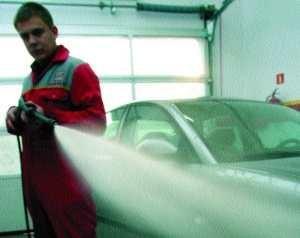
How to care for varnish
 Just as we change tires or windshield washer fluid before winter, the paintwork must also be prepared for changing operating conditions.
Just as we change tires or windshield washer fluid before winter, the paintwork must also be prepared for changing operating conditions.
Monitoring the condition of the car body and properly protecting it from adverse conditions will not only allow you to enjoy the good condition of the car for a longer time, but is also one of the requirements on which the preservation of the anti-corrosion guarantee depends. It does not cover damage resulting from use, such as scratches or chips on the paint.
|
Before paint care thoroughly wash the entire car. Photo by Robert Quiatek |
“Like changing tires or windshield washer fluid before winter, the paintwork must also be prepared for changing operating conditions,” says Ryszard Ostrowski, owner of ANRO from Gdańsk. We can do most of the minor repairs ourselves. This will allow you to avoid progressive corrosion and significant costs for subsequent repairs. However, this only applies to minor damage to the paintwork, larger chips or deep scratches usually require the intervention of a professional varnisher.
“Modern metallic automotive paints consist of several layers and without the appropriate equipment it is difficult to remove the damage that has occurred on them,” says Ryszard Ostrowski. – Do-it-yourself repairs will not completely remove scratches, but can protect the bodywork from progressive corrosion.
At the next stage, we can contact a specialized company, where the paintwork of our car will be thoroughly restored.
Ten steps to permanent varnish
1. The first step is to thoroughly wash the car, ideally both the underbody and the outside. In order for preservatives to do their job well, the body must be perfectly clean. This is important because during the next maintenance steps, any contaminants remaining on the paintwork can further damage it.
2. Let's check the condition of the chassis, which is more susceptible to adverse conditions in winter. We are looking for visible damage, scratches and losses, especially in the area of \uXNUMXb\uXNUMXbthe wheel arches and sills. These places can be covered with special, adapted masses based on rubber and plastic.
3. The next step is to inspect the body. It requires careful inspection - our attention should be paid to all chipped paint, scratches and traces of rust. If the damage to the paint is not very deep and the factory primer is in good condition, just cover the damage with paint. You can use special aerosol varnishes or a container with a brush.
4. If the damage is deeper, first protect it by applying a primer - paint or anti-corrosion agent. After drying, apply varnish.
5. More effort is required to fix already rusted damage. Corrosion must be carefully removed with a scraper, anti-corrosion agent or sandpaper. Only then can the primer and varnish be applied to a thoroughly cleaned and degreased surface.
6. If we find bubbles of peeling varnish or mounds of paint sagging under pressure, tear them off and remove the varnish to the place where the sheet is holding. Then use an anti-corrosion agent and only then a varnish.
7. After the applied paint has dried (according to the manufacturer's instructions), level the layer with very fine sandpaper.
8. We can use a special polishing paste, the slightly abrasive properties of which will remove dirt and scratches from the surface of the body.
9. Finally, we must protect the bodywork by applying car wax or other preparations that protect and polish the paint. Waxing can be done on your own, but it is more convenient to use the services of automotive companies that offer such an activity.
10 When driving in winter, remember to periodically check the condition of the paintwork and repair any damage regularly. After each wash, we must maintain door seals and locks to prevent them from freezing.


